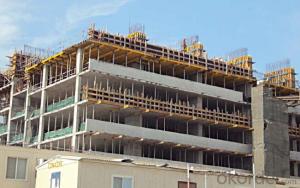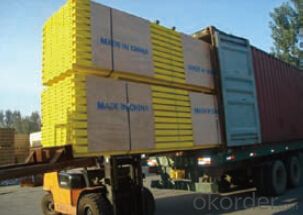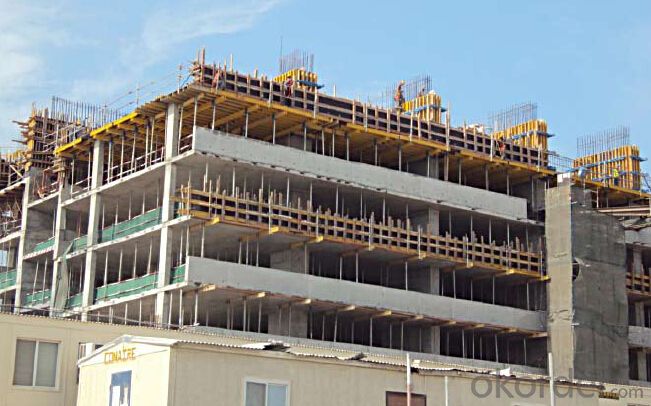Timber-Beam Formwork and H20 for Formwork and scaffolding system
- Loading Port:
- Tianjin
- Payment Terms:
- TT OR LC
- Min Order Qty:
- 50 m²
- Supply Capability:
- 1000 m²/month
OKorder Service Pledge
OKorder Financial Service
You Might Also Like
Characteristics:
◆ Standardized production lines.
Supply capability: 3000m/day, Lmax = 6600mm.
◆ Finger jointing of the flange and web, the strength of timber beam is highly improved.
Max. shearing force failure load:40KN
◆ Well treated to prevent from water penetration or erosion, so the service life maximally
extended.
Normally, CNBM timber beam H20 can be used for 4 to 5 years, the exact using time would
depend on maintenance & storage.
◆ Robust caps at the end of the girders protect against damages.
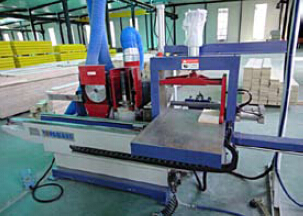
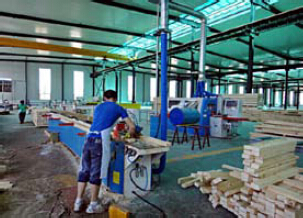

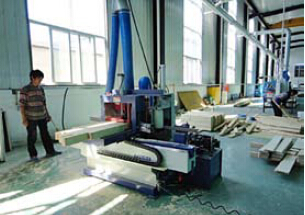
- Q: What are the safety precautions when working with steel formwork?
- When working with steel formwork, it is important to follow several safety precautions to ensure the well-being of workers. These precautions include wearing personal protective equipment (PPE) such as hard hats, safety glasses, gloves, and steel-toed boots. It is also crucial to inspect the formwork for any damages or defects before using it, as well as to secure it properly to prevent collapse or movement during construction. Adequate training and supervision should be provided to workers, and they should be cautious of potential hazards such as sharp edges, heavy lifting, and working at heights. Regular communication and adherence to safety protocols are key to minimizing accidents and ensuring a safe working environment.
- Q: Are there any environmental benefits to using steel formwork?
- Yes, there are several environmental benefits to using steel formwork in construction projects. Firstly, steel formwork is highly durable and can be reused multiple times, reducing the need for new formwork materials. This significantly reduces the amount of waste generated during construction, as traditional formwork materials like timber are often discarded after a single use. By using steel formwork, construction companies can minimize their environmental footprint by reducing the amount of waste sent to landfills. Additionally, steel formwork is recyclable, meaning that at the end of its lifecycle, it can be recycled and repurposed into new steel products. This helps to conserve natural resources and reduce the demand for raw materials. Furthermore, the energy required to recycle steel is significantly less than the energy required to produce new steel, resulting in reduced greenhouse gas emissions. Steel formwork also offers advantages in terms of energy efficiency. Compared to traditional formwork materials, steel formwork requires less energy to manufacture and transport, resulting in lower carbon emissions. Furthermore, steel formwork is known for its high strength and rigidity, which allows for the construction of more slender and lightweight structures. This can lead to reduced material consumption and subsequently lower energy requirements for heating, cooling, and lighting in the constructed buildings. Lastly, steel formwork is resistant to moisture, fire, and pests, reducing the need for chemical treatments and preservatives that can harm the environment. This makes steel formwork a more sustainable option and reduces the negative impact on ecosystems and human health. Overall, the use of steel formwork in construction projects offers several environmental benefits, including reduced waste generation, increased recycling opportunities, energy efficiency, and reduced reliance on harmful chemicals. By choosing steel formwork, construction companies can contribute to a more sustainable and environmentally-friendly construction industry.
- Q: How does steel formwork help in achieving a high-quality finish?
- Steel formwork helps in achieving a high-quality finish due to its ability to provide a strong and rigid structure for concrete placement. Its smooth and non-absorbent surface prevents the formation of air bubbles, resulting in a smooth and even finish. Additionally, steel formwork allows for precise and accurate shaping and alignment, ensuring the desired dimensions and contours of the final concrete product.
- Q: I was engaged in the patent agency, the two days of receipt of a patent application on the bridge, it is a drawing section map, the other nothing, no label no text, I am on mechanical, civil engineering drawings and utterly ignorant of ah, so simple, later on the Internet for a long time and recall ratio of patent it is unclear whether the drawings, sections of the box girder template, now the goal is clear, but a box girder template knowledge I don't know much about the Internet, did not find out what things, patent is only a few patents, I want to know more about the box girder and box girder template for example, the box girder template with cast-in-place prefabricated, full steel structure, steel wood structure, the hydraulic support system, but also ordinary (the ordinary I don't know what), etc. So, anyway, more detailed information as possible, thank you ~ ~ no more, I don't mind ah, not much, have a point with the province oh
- I am specialized in Civil Engineering (design and construction), you see the drawings are box girder template for the design of template
- Q: How does steel formwork compare to wooden formwork in terms of cost?
- Steel formwork is generally more expensive than wooden formwork. However, it offers longer durability and can be reused multiple times, reducing the overall cost in the long run. Additionally, steel formwork provides better accuracy and stability, resulting in improved quality of construction.
- Q: How does steel formwork handle different concrete finishing techniques?
- Steel formwork offers a wide range of possibilities for concrete finishing techniques due to its high versatility. It possesses great strength and durability, enabling it to withstand the pressure and forces exerted throughout various finishing procedures. When aiming for a smooth finish, steel formwork provides a solid and stable surface that facilitates easy pouring and leveling of the concrete. Its rigidity guarantees that the concrete remains in position and does not sag or deform during the finishing process. Consequently, the concrete can be smoothly troweled, resulting in a polished and uniform surface. Steel formwork is also suitable for textured finishes. It can be customized with different patterns and textures to create unique and decorative concrete surfaces. By utilizing specially designed steel formwork, such as those with corrugated or embossed patterns, the concrete can be poured to replicate these designs, resulting in visually appealing textured finishes. Furthermore, steel formwork is capable of accommodating exposed aggregate finishes. This technique involves removing the top layer of concrete to reveal the underlying aggregate stones, thus creating a decorative effect. Steel formwork can be designed with removable panels or inserts that allow the concrete to be poured in a way that exposes the desired amount of aggregate. After the concrete has cured, these removable panels can be easily taken off, revealing the desired exposed aggregate finish. Moreover, steel formwork is suitable for stamped concrete finishes. Stamped concrete involves imprinting patterns or textures onto the concrete surface using specialized stamps. Steel formwork provides a solid foundation for these stamps to be pressed onto, ensuring accurate and consistent imprints. The rigidity of steel formwork prevents the concrete from shifting or deforming during the stamping process, resulting in precise and high-quality stamped finishes. Overall, steel formwork is highly compatible with various concrete finishing techniques. Its strength, stability, and versatility make it an ideal choice for handling different finishing processes, allowing for the creation of smooth, textured, exposed aggregate, and stamped concrete finishes with precision and ease.
- Q: What is steel formwork?
- Steel formwork is a type of temporary structure made from steel that is used in construction projects to create the desired shape and structure of concrete elements such as walls, columns, and slabs. It provides a strong and durable framework for the concrete during the pouring and curing process, ensuring accuracy and stability in the final structure.
- Q: Can steel formwork be used for both slab and beam construction?
- Yes, steel formwork can be used for both slab and beam construction. Steel formwork is versatile and can be easily adjusted and customized to suit various shapes and sizes of slabs and beams. Its strength and durability make it suitable for handling the heavy loads and pressures involved in both slab and beam construction.
- Q: How does steel formwork handle formwork stripping time?
- Steel formwork is renowned for its durability and strength, characteristics that contribute to its exceptional efficiency in handling formwork stripping time. Unlike traditional wooden formwork, steel formwork has the capacity to endure multiple uses while maintaining its structural integrity. As a result, the stripping time required for steel formwork is significantly reduced when compared to other formwork materials. The rigid construction of steel formwork allows it to bear the weight of concrete and resist deformation during the pouring and curing processes. Consequently, the formwork can be removed more quickly once the concrete has set, as there is less concern about damaging or distorting the formwork. Furthermore, the design of steel formwork incorporates smooth and non-porous surfaces. This characteristic prevents the concrete from bonding with the formwork, facilitating an easier and faster stripping process. Additionally, the smooth surface contributes to a superior finish of the concrete, reducing the need for additional finishing work. Moreover, steel formwork systems often include adjustable features such as adjustable props and modular panels. These features enable easy adjustment and repositioning of the formwork, further enhancing the efficiency of the stripping process. This adaptability allows for faster stripping and reusability of the formwork, resulting in significant time and cost savings. In conclusion, steel formwork excels in managing formwork stripping time due to its durability, strength, and smooth surface. Its ability to withstand multiple uses, resist deformation, and prevent concrete adhesion makes steel formwork highly efficient and time-saving in the construction industry.
- Q: Can steel formwork be used for school construction projects?
- Yes, steel formwork can be used for school construction projects. Steel formwork offers durability, strength, and stability, making it suitable for various construction applications, including school buildings. It provides a reusable and efficient solution for creating concrete structures, allowing for faster construction and cost savings. Additionally, steel formwork can be easily customized to meet specific design requirements and offers a high level of quality and precision in construction projects.
Send your message to us
Timber-Beam Formwork and H20 for Formwork and scaffolding system
- Loading Port:
- Tianjin
- Payment Terms:
- TT OR LC
- Min Order Qty:
- 50 m²
- Supply Capability:
- 1000 m²/month
OKorder Service Pledge
OKorder Financial Service
Similar products
Hot products
Hot Searches
Related keywords

